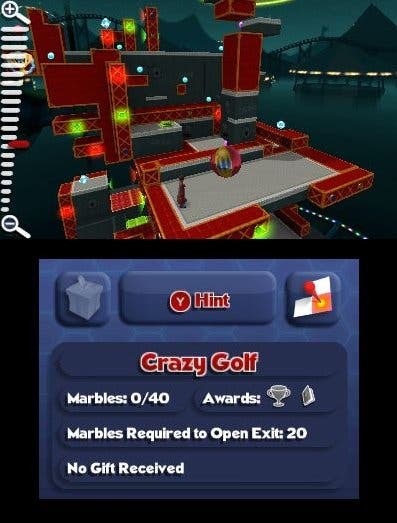Crush3D Review
Marble madness.
Crush3D is a refreshed version of Zoe Mode's Crush, a smart, innovative platform-puzzler for the PSP which involved switching gameplay between 2D and 3D to progress - and immediately you can see why a 3DS version now exists.
You navigate the game's abstract levels as Danny, a psychologically troubled teenager dressed in an Arthur Dent-style dressing gown. Each course comes from his own subconscious, his mind trapped inside a mad scientist's machine.
Collecting your marbles (the not-so-subtly-named spherical items dotted around each level) will unlock an exit, but it's then a matter of getting there. Danny's a feeble little blighter, only able to jump a foot in the air and fond of perishing after too steep a fall. His limits are fairly realistic, in other words, but for a video game he is rather gratingly underpowered.
So jumping sequences are thankfully kept to a minimum, with pathways through levels instead uncovered by "crushing": flattening the landscape from 3D to 2D (or vice versa). A staircase of gently ascending but separated blocks can become a ladder, for example, or a distant marble might be concertinaed from the background to the foreground for you to snatch.

Much of the difficulty comes in finding the right perspective to crush the level from, be it rotating the camera to one of four side-on perspectives or switching to a bird's-eye view so the level becomes a top-down maze. Juggling the options in your mind along with each course's geography makes for a considerably smarter affair than Super Paper Mario's simple dimension switching (and to be fair, it was also conceived first) - although with added complication come some problems.
Crushing is performed with a touch of the L button, while rotating the camera from one 90-degree angle to the next is mapped to the D-pad. One of the inherent issues of having a camera locked into a limited range of views is that if you ever move Danny out of direct eye-line, the game tries to compensate by switching view for you, with frequently mixed results. For a game so based around navigating from the correct viewpoint, it's an irritating niggle.
Quickly, you find yourself having to manipulate the environment around you more to progress. Switches, moving platforms and other items must be maneuvered to secure your route, and Crush3D is happy to throw these at you in quick succession. The difficulty is set so you'll be able to negotiate levels at a reasonable rate, although some maps I felt I had solved more through blind luck and experimentation than skill.
When you do get stuck, Crush3D has a generous hint system that tracks your progress through the level. Called up with a touch of the X button, it is able to suggest your next move to progress one step further. Not too little help, not too much; a happy medium of spoilers. And for those who really want the process laid out for them, more detailed instructions are available for the price of one marble.
Such a comprehensive help system is a useful thing, but the ease of its use can undermine the game's difficulty - and this is a real problem. When you're using it to polish off levels you could still probe further, you realise the game's puzzles are beginning to lack the sticking power to keep you interested.
After the cleverness of its main dimension-changing conceit wears off, Crush3D starts to lack the sort of sparkle of that drives further exploration. Touches of cleverness - such as "thought" graffiti which blocks Danny from crushing but that can be put 'out of sight, out of mind' by rolling an item in front - become far too infrequent to be truly refreshing.
The story is bizarre and oddly dark, conveyed through snippets of text at the beginning of levels and disappointing cut-scenes between worlds. The puzzles found in Danny's wonky subconscious get harder, you discover, as he explores repressed memories from his youth, full of childhood fears and monsters. The cut-scenes are simple 2D artwork and speech bubble affairs.

The rest of the game looks crisp, Crush3D's fresh palette overhauled since the moody PSP original. Gone are the grungy brown backgrounds and torrential-rain-soaked landscapes, found even on the PSP version's beach levels. Crush3D has a cleaner, brighter colour scheme, better for quickly assessing a level's topography.
Also new is the game's StreetPass feature, which allows you to swap one 3DS Play Coin for 10 "gifts" that you can strategically place within levels. StreetPass someone else with the game and your gift appears in their version of the level: a mini flag to show off a devilish hiding spot you've found. In the continued absence of a level editor, something the creators once expressed an interest in adding to the original, it allows a form of customisation of levels and adds a reason to replay courses, if you can be bothered.
There's also concept art and alternate colours of dressing gown to be unlocked, should you want to collect all the marbles in the game and fancy wearing a blue camouflage robe. Each level also has a trophy that unlocks a harder version of the course played against the clock and with a limited number of crushes available.
While crushing remains an intriguing mechanic, Crush veterans will have to search hard to find their money's worth underneath the game's wet coat of paint. When you remove the 3D from Crush3D it is, by and large, the original offering.
A game that's ingenious but ultimately a little tedious, this puzzle oddity is a brain-teaser that will boggle your mind at least as long as your patience lasts.


